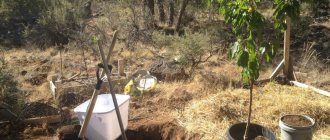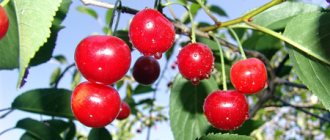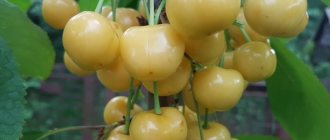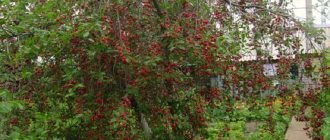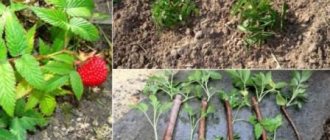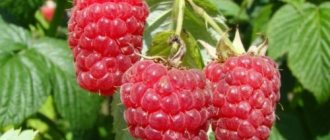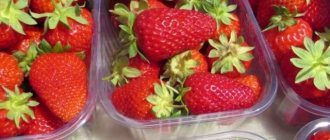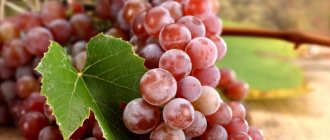Description of culture
The culture is vigorous, but the Gronkovaya cherry variety has an average height. The tree grows quickly, reaching a size of 4.5-5 m when mature.
Gronkova's crown is medium-dense and wide-pyramidal in shape. The shoots are of medium length and thickness, growing straight. The skin is brown in color.
The leaves are small compared to the normal size of cherry leaf blades. They have the shape of an ellipse with a pointed end, and are painted dark green.
Gronkova’s fruits are heart-shaped and one-dimensional. The skin is dark red. The pulp is the same color and juicy. The small bone comes off easily. The weight of one berry is about 5-6 g.
The description of the Gronkovaya cherry variety should be continued by listing the taste parameters. The fruits are sweet, dessert taste. The tasting score of Gronkovaya cherries is 4.8 points. The variety is most widespread in the regions of the Republic of Belarus - Mogilev, Gomel, Brest, Vitebsk, Grodno. It is also recommended to grow the variety in a region with similar climatic conditions - the North Caucasus or the Astrakhan region.
An important addition to the description will be a photo of the Gronkovaya cherry.
Gronkovaya cherry: description of the variety
Cherry Gronkovaya: photo
Very outstanding breeders worked on the creation of the Gronkovaya cherry variety - E.P. Syubarova, V.S. Zhuk, M.I. Vyshinskaya and R.M. Sulimov, who are the authors of several more very popular sweet and sour cherry varieties. This variety was included in the state register in 1999, and since then it has begun to be cultivated in different parts of our country.
Gronkovaya cherry is a vigorous planting; the tree is medium in height, but at the same time quite large, so sometimes gardeners may complain that it is problematic to care for the plantings. In any case, a strong tree can withstand some truly unfavorable climatic and weather conditions, making it easier for the gardener to create agronomic conditions for healthier plantings.
The crown is wide and has a pyramidal shape, but in general the gardener can shape it in accordance with his wishes and tastes. The crown is densely leafy, it looks quite interesting and attractive, and its impressive size only benefits the planting.
The most important thing is that during flowering the Gronkovaya cherry turns into a snow-white and fragrant cloud that amazes the imagination of gardeners. Next, I would like to dwell in more detail directly on the description of the external characteristics of the variety and the characteristics of the harvest.
In principle, this tree looks quite standard by the standards of cherry plantings, and sometimes some may confuse this variety with many others. But still, we should not forget that the plant has its own unique features and characteristics, which are taken into account when selecting activities related directly to care.
The buds are of medium size; they must be viable, since new shoots and branches will blossom from them in the future and a harvest will form. The leaves are flat and quite large, they look like ordinary leaves on cherry plantings, rounded, the edges may be slightly retracted and pointed.
During flowering, a large number of leaves are formed on the tree, and therefore the crown always looks very thick and elegant, generally demonstrating excellent results in its growth and development, as well as in decorativeness.
The crown is medium dense, the trunk is covered with smooth bark. The bark itself has a slightly brown color, but over time it can darken and peel off, which indicates that the tree is gradually maturing, and it is worth looking after it more carefully so that it bears fruit for as long as possible and pleases gardeners with its abundant and tasty harvest.
The leaves have an elliptical shape, the tips are slightly pointed - in general, this is a fairly typical leaf shape, which is found in both cherry and cherry crops, which are each other's closest relatives.
Flowers can be located singly, or there can be bouquets-inflorescences that consist of three flowers. These are mainly female flowers, which are colored in a light pinkish-cream shade. Basically, during flowering, the planting looks really incredibly attractive and attractive, the plant looks decorative, and the flowers themselves are very fragrant.
Therefore, more experienced gardeners choose cherries not only to get a harvest, but also to decorate their garden plot with such a delicate and wonderful tree.
The growing season is about 70 days. The fruits are large, the weight of one berry can be about seven grams, and in shape they more closely resemble slightly rounded hearts. The color of both the skin and the pulp is red, the juice is also red.
The taste characteristics are rated quite highly; tasters emphasize the sweet taste of the berries and the density of the pulp, which allows the fruits to be stored for a long time and transported over long distances.
The berries also retain their integrity for a long time even when harvested - another advantage for those who do not yet know how to fully realize their harvest.
This variety is recommended for cultivation in temperate climates, mainly in the southern or central parts of Russia. But there are experienced gardeners who say that they were able to grow cherries in less stable areas, and the harvest was no worse in quality.
Characteristics
The main characteristic of the Gronkovaya cherry variety is the ripening period. The species belongs to the early ones, so all other parameters depend on the developmental characteristics of the early cherry.
Drought resistance, winter hardiness
Gronkova's winter hardiness is high. Slightly inferior in parameter to plum, pear and apple tree. The variety is valued for its ability to withstand low temperatures and frosts, but for the winter period the tree requires shelter. If autumn events are carried out correctly, the variety can withstand frosts down to 24 °C. A number of factors influence Gronkova’s winter hardiness:
- fertilization;
- preparatory activities for winter;
- location of the garden plot;
- terrain.
Important! The early start of the growing season requires caution during the onset of spring frosts so that the flower buds are not damaged.
Pollination, flowering period and ripening time
The Cherry variety Gronkovaya is self-sterile. To get a good harvest, you need to plant other species nearby. The following pollinating varieties are best suited for Gronkovaya cherries:
- Rival;
- Sap;
- Folk;
- Zhurba;
- And the way;
- Hotel;
- Syubarovskaya.
Gronkovaya blooms in early spring, and the fruits are ready for picking at the end of June.
Productivity, fruiting
The productivity of the cherry variety is high, fruiting is regular every year, from 65 to 90 centners of ripe berries are collected from 1 hectare. The value depends on compliance with agrotechnical requirements and climatic growing conditions. The first Gronkova harvest is harvested in the 4th year after planting the seedling.
Area of application of berries
The best use of the Gronkovaya variety is to enjoy fresh berries.
When cherries ripen, there is not yet enough vitamins in the garden. Therefore, the optimal type of preparations from early varieties is compotes. It is better to make jam or preserves from later varieties of cherries.
Resistance to diseases and pests
The Gronkovaya variety is highly valued for its resistance to diseases and pest attacks. The plant demonstrates the greatest immunity to coccomycosis.
Advantages and disadvantages
Based on the description of the Gronkovaya cherry, you can make a list of the pros and cons of this type. Among the advantages, gardeners note:
- regular high yields;
- winter hardiness;
- early ripening;
- decent taste and product qualities;
- precociousness;
- disease resistance.
And the disadvantages of the Gronkovaya variety are:
- self-sterility;
- short shelf life;
- average transportation rate.
Cherry-cherry ups and downs
The strawberries have not yet left, and we are already feasting on cherries with all our might. I would like to eat some cherries too. Will it work? This and many other questions were asked on July 8 in the garden of the Republican Unitary Enterprise “Institute of Fruit Growing”. An impromptu seminar for cherry and cherry lovers took place here. It was conducted by the head of the laboratory of genetic resources of fruit, nut crops and grapes of the Republican Unitary Enterprise "Institute of Fruit Growing", Candidate of Agricultural Sciences Alexander Taranov.
The history of cherries and cherries are closely intertwined.
In the Middle Ages, these two plants were considered different varieties of the same crop and were simply called Cerasus, adding the word “sweet” to the cherry and “sour” to the cherry. In English-speaking countries such names are still preserved. And only in the Belarusian and Russian languages these cultures are called differently. Are the cherries ripe?
We immediately looked into the cherry orchard. Alas, there were only a few fruits on the trees.
“Yes, there are practically no cherries this year,” Alexander Alexandrovich, catching our glances, commented on the situation. “And to a greater extent because it suffered from frosts that occurred in April and May. Wintering this year was generally anomalous. The ground remained unfrozen until the New Year. There were also thaws, during which plants lost their hardening and came out of a state of deep dormancy. And then on January 7-8, almost 30-degree frosts struck. And such changes hit the flower buds of stone fruit crops the hardest. Including cherries and sweet cherries. The weakly winter-hardy (specifically flower bud) cherry varieties of the Belarusian selection “Beauty” and “Gronkovaya” had already lost about 80% of their flower buds at that time. And then spring frosts made the situation even worse. The “Minchanka” variety withstood the winter cold, but the May frosts damaged its pistils by almost 40%. After such weather anomalies and freezing, fruit plantings are attacked by diseases. Including the milky shine. That’s why there are big attacks in the garden: such trees are uprooted. This year, although difficult, is also a testing year! Weak varieties were immediately eliminated, and the most resistant ones became more noticeable.
Cherry is a fairly winter-hardy fruit species, similar in this respect to the apple tree. But due to the devastating epiphytoties of coccomycosis, and in recent years, monilial burn, in the absence (or untimely implementation) of protective measures, it sometimes freezes out even in ordinary winters, and in severe ones, which periodically repeat every 8 - 10 years, it dies in entire blocks.
Mass cherry blossoms occur in the first or second decade of May and last 1-2 weeks. Pollen from one flower is capable of pollination for 1 - 5 days. But it is most effective in the first three days after opening. If during flowering the temperature drops to plus 10 - 12 degrees (which was the case this year), the pollen partially loses its ability to fertilize. As a result, unfertilized or insufficiently fertilized flowers (even if the ovary has increased in size) and underdeveloped fruits fall off.
"The Legend of Mliev."
Cherry pollen, like other fruit crops, is “heavy” and the wind cannot transfer it from plant to plant. This work is performed by bees and bumblebees. If there are no insects, then no matter how favorable the conditions for flowering are, do not expect a good harvest.
Among the cherry varieties, there are both self-fertile ones, which are capable of setting fruit when more than 20% of the ovary is pollinated by its own pollen, and self-sterile or sterile ones - their percentage of fruit set from self-pollination is no more than 5%. That is why the selection of pollinating varieties is so important. If they are not there, fruits cannot form. Therefore, after flowering, young undeveloped ovaries dry out and crumble. When pollinated by the best pollinators, even self-fertile varieties increase yield.
"Vyanok."
“Currently, it is very difficult to find self-fertile (and therefore high-yielding) cherry varieties that are also highly resistant to coccomycosis and moniliosis,” admits Alexander Taranov. “Although there are varieties with complex resistance to diseases, they are self-sterile and bear fruit abundantly only under favorable conditions. Conversely, most self-fertile varieties (“Zhagarskaya”, “Kistevaya”, “Lyubskaya”, “Molodezhnaya”, “Nefris”, etc.) are severely affected by coccomycosis and moniliosis.
Work on the selection of cherries and sweet cherries began in 1927 by E.P. Syubarova. Since 1965, R.M. Sulimova has devoted more than 20 years to the selection of these crops. Then M.I. Vyshinskaya continued the painstaking work of preserving and expanding the collection. And now Alexander Taranov has picked up the baton.
The institute’s collection, one of the richest in the CIS, already contains more than 260 cherry varieties of domestic and foreign selection. And in the state register, along with Belarusian (and there are more than half of them) Russian varieties, Russian ones are also widely represented: “Vladimirskaya”, “Antonovka Kostychevka”, “Lyubskaya” (or “Lutovka”), “Rovesnitsa”, “Livenskaya”, “Orlitsa”, “ Orgolia", "Mtsenskaya"…
"Lasuha."
It is gratifying that some of our varieties (“Seyanets No. 1”, “Novodvorskaya”, etc.), released in the 60s of the last century, are still not losing their positions.
Due to its high self-fertility (up to 45%), the “Rovesnitsa” variety, as a rule, always produces a harvest. But now both on it, and on the high-yielding variety “Lyubskaya”, and on the Hungarian “Pren Koray” there are single fruits. This year, the Serbian self-fertile variety “Oblachinskaya” with a compact and low crown, which had proven itself well in previous years in the Brest region, was also unable to realize its potential. But “Nika” pleased me. Its fruiting rate is no more than 3 points out of 5, but it still stands out compared to other varieties.
It must be said that young trees are much more productive than adults, in which fruiting shifts to the periphery, exposing long branches. And you can’t do without pruning, relying on three-year-old branches.
"Seedling No. 1."
This winter has also become a test for the varieties that were the last to be submitted for state testing - “Milavitsa”, “Nesvizhskaya”, “Confiture”, the degree of fruiting of which is 1 - 2 points. Only the first two varieties confirmed their resistance to major diseases. "Confiture", alas, failed - I began to get seriously ill. The situation can only be corrected by treatments (with the same “Chorus”) before flowering.
“Nesvizhskaya,” emphasizes Alexander Taranov, “is today considered the most resistant variety to coccomycosis and is not affected by monilial burn. This is a folk variety: during the expedition we found it in the Nesvizh region.
Need a pair
During the conversations and questions, they didn’t notice how they ended up in the cherry orchard.
It is believed that the cherry season is very short, but this is not true. The first, earliest varieties ripen at the end of June, and the latest - in mid-August. It happens that in the spring cherries are encouraging with abundant flowering, and then suddenly disappoint with a meager harvest. Despite the fact that they can withstand 25-degree cold weather without loss, they still succumb to the May frosts.
"Toy".
“Nevertheless, in recent years, cherries have been in a better position compared to sour cherries,” Alexander Alexandrovich makes it clear. — At the time of the May frosts, it already has a fairly large ovary, which is more resistant to low temperatures than newly opened cherry flowers.
Also, one of the reasons for the low yield of cherries is the fall of the ovary due to freezing of flower buds, poor pollination or the absence of a pollinator variety at all.
As for the most winter-hardy varieties of cherries, these are “Severnaya”, “Narodnaya”, “Fatezh”, “Iput”. Even after harsh winters, these varieties retain some of their flower buds. Also, among the studied collection varieties, high winter hardiness (freezing of no more than 0.5 points) was shown by “Bryanochka”, “Teremoshka”, “Tyutchevka”.
A test is underway.
In terms of winter hardiness of flower buds, they stand on “Severnaya”, “Syubarovskaya”, “Tyutchevka”, “Fatezh”. The “Severnaya” variety can be considered the standard for winter hardiness of both wood and flower buds.
When selecting the assortment of cherries, it is necessary to take into account the cultivation zone. For the Vitebsk and Mogilev regions, the most reliable and winter-hardy varieties will be “Severnaya”, “Narodnaya”, “Yantarnaya”. In the central and southern garden zones (and these are the Grodno and Gomel regions) it is advisable to grow “Gascinets”, “Gronkovaya”, “Syubarovskaya”, “Naslazhdeniye”, “Minchanka”, “Rival”.
Cherries begin to bear fruit early: the first berries appear already in the second or third year after planting. A good harvest is harvested on the fifth or sixth. Cherries will regularly bear fruit every year, unless, of course, the blossoms are frost-damaged. For it, as a self-sterile crop (that is, unable to be pollinated by its own pollen), a pollinator variety is very important. To ensure cross-pollination, it is necessary to plant at least two mutually pollinating varieties on the site.
"Zhyvitsa."
“Iput” is a universal pollinator, compatible with many varieties. Pollination is considered good if about 30% of flowers have set. At Iput, this figure reaches 80%. A good pollinator and the “Northern” variety.
The excursion to the cherry orchard turned out to be more “tasty”: you could not only taste the berries, but also pick them. The size of the fruit was amazing. “Naslazhdeniye” has them weighing 6–7 g. By the way, cherries with berries weighing more than 6.3 g are considered large-fruited.
The flesh of “Naslazhdeniye” is dense and resistant (unlike most other varieties) to cracking. The trees are low-growing and in terms of winter hardiness they are at the level of “Gascints”. This variety is ideal for the central part of Belarus, but in the Vitebsk and Mogilev regions it can freeze slightly in severe winters.
"Miracle Cherry".
“Gronkovaya” is a mystery variety. It came from “Severnaya” by free pollination. It does not have very winter-hardy flower buds, but it does have very winter-hardy wood. Therefore, this variety is successfully grown even in the central region of Russia. He is more than comfortable with us.
The variety "Syubarovskaya" was obtained from crossing "Severnaya" and "Pobeda". The first is the standard for winter hardiness, and the second is for large-fruitedness. And in this difficult season, “Syubarovskaya” escaped all the disasters, preserving the flower buds. Perhaps this became possible also because it blooms much later than other varieties. But “Syubarovskaya” has cracked fruits. The reason is irregular watering: at first it was hot and there was little moisture, and then suddenly it started raining all at once. If you protect the plantings from excess moisture during ripening, then such a picture can be avoided. The solution is film shelters. And with proper watering you can regulate the weight of the berries.
“Lungwort” was also pleased with the harvest. This means that its flower buds are more winter-hardy. The fruits are not large (up to 5 g), but very tasty. Really honeyed.
The variety “Vityaz” received its name in honor of Vitebsk: winter-hardy and very productive. The “Rival” variety is also quite winter-hardy. In severe winters, when the air temperature dropped to minus 33 degrees, the overall degree of freezing did not exceed two points. And this is at the level of the most winter-hardy cherry variety in Belarus, “Severnaya”. In addition, “Rival” is highly resistant to coccomycosis. Plus - large (up to 7 g) fruits with dense pulp. “Minchanka” is considered the most promising variety in terms of fruit quality.
Among the new products is the “Maria” variety (hybrid 17/59) - the result of crossing “Narodnaya” and “Valery Chkalov”. The result was a large-fruited (berry weight from 6.1 g) and winter-hardy variety.
In the collection part of the garden, the “Legend Mlieva” variety has simply huge fruits: 12 - 13 g. And this variety is valuable precisely for its large fruit. The Donetsk variety “Lyubava” is also used as a large-fruited parent form. Cherry hybrids that promise to be promising are under the special control of Belarusian scientists. Hybrid 4/10 used to ripen in early August, now it ripens in mid-July. The mid-late hybrid 10/97 has large (average weight 7 g) fruits. And in the hybrid 15/126 they weigh 8 - 10 g. It is the largest-fruited of all hybrids and is included in the elite as a contender for a future variety.
But even 10 g is not the limit for cherries. In Melitopol, breeders V.A. Turovtseva and N.I. Turovtsev bred especially large-fruited cherry varieties. The average fruit weight for the “Announcement” and “Prestizhnaya” varieties is 10–12 g, the maximum is 14–15 g, for the “Large-fruited” variety (respectively) 10–12 g and 18 g. Fantastic!
When visiting Ukraine, Alexander Taranov always compares their varieties with ours. And he admits that we are not so far behind our southern neighbors. But you must admit that our climate is not the same. And if Ukrainian breeders bring their large-fruited varieties to us, then our late varieties are taken from Belarus - they don’t have those.
"Gronkavaya."
An important issue is the height of the trees. It turns out that there are already low-growing varieties of cherries. The RUE Institute of Fruit Growing is testing clonal rootstocks VSL-2 and Izmailovsky. Mature trees on so-called semi-dwarf rootstocks still grow no lower than 4 m. The varieties “Yantarnaya”, “Fatezh”, “Syubarovskaya” have a spreading and drooping crown. The branches grow at an obtuse angle and sometimes bend down to the ground. And the fruits themselves are hidden under the foliage and are not immediately visible to the eye. This has its own advantage - a kind of insurance against bird attacks.
The VSL-2 rootstock is resistant to root rot. And thanks to its branched and deep root system, it is drought-resistant. Therefore, it feels great in our conditions even without additional watering. But it has one property (not necessarily a bad one) - hypersensitivity to viral infections. And if you graft an infected scion onto it, rejection will certainly occur. That is, the graft will not grow together.
Mysterious Dukes
In the institute's garden there are also cherry-cherry hybrids, the so-called duki. 20 genotypes of Ukrainian selection - “Donetsk Shpanka”, “Igrushka”, “Nochka”, “Miracle Cherry”, “Melitopol Dessert”, “Ksenia”, “Slavyanka” and others. Four Russian varieties - “Excellent Venyaminova”, “Beauty of the North”, “Caucasian”, “Caucasian Black”. And a variety of Belarusian selection - “Zhyvitsa”. By the way, there is only one and it is zoned in Belarus.
"Pleasure".
— Dukes that meet international standards are more like cherries: a powerful trunk, a sparse crown. The leaves and flowers are larger than those of cherries, but just as dense and shiny. The fruits are also huge—sometimes they reach 8–10 g. The duki taste sweeter than cherries and have a slight sourness,” Alexander Alexandrovich continues the story. — Fruits are formed on bouquet branches and on last year’s growth. After 3 - 4 years, the productivity of bouquet branches decreases, and in the 7th - 8th year they completely die off. With age, when growth processes weaken, fruiting is concentrated on short shoots. Despite the not very high winter hardiness that dukes inherited from cherries, they can bear fruit for 20 - 25 years. Their yield largely depends on the degree of self-fertility of the variety, weather conditions during flowering and fruit set, disease resistance, level of agricultural technology, etc.
For the most part, hybrids between cherries and sweet cherries are sterile or almost sterile. They bloom profusely, but set little or no fruit. And among themselves, dukes are poor pollinators. Once they find themselves in an area where there are few cherries and cherries, they may not find a suitable match. Or, despite genetic compatibility, they may not coincide in terms of flowering. Therefore, when starting a duke, be sure to think about the pollinator variety. Without it, you can’t count on a good harvest. Among the most famous cherry varieties such as “Donchanka” and “Valery Chkalov” are suitable as pollinators.
Variety of the future
An important issue for cherry lovers is protecting the crop from birds. Alexander Taranov considers covering trees with netting to be the most reliable. And not only from above, but also from below. You can also swaddle trees with spunbond.
"Northern".
While working in the garden, the scientist noticed one feature: birds (if they have a choice) prefer dark and bright red fruits. They are almost not attracted to yellow and whitish ones. Early varieties suffer most from bird attacks. But as soon as the grains ripen in July, the birds migrate together to the grain fields. Therefore, middle and late varieties of cherries remain practically untouched.
There are gauze bags hanging on many trees. This is a sign that breeders are combining different varieties to obtain new ones: in adaptability they are not inferior to the best varieties released in Belarus, and in fruit quality they are as close as possible to the southern ones. Scientists want to combine in one genotype the size of the fruit (8 - 10 g), winter hardiness of wood and flower buds at the level of the standard variety “Severnaya”. Resistance to coccomycosis has almost been achieved: cherries are rarely affected by this disease.
The plans include creating self-fertile varieties of cherries. They exist in the world. There are such samples in the institute’s collection: these are the Canadian varieties “Stella” and “Skina”. But “Stella” turned out to be weakly winter-hardy. “Skina” is actively attracted as a self-fertile paternal form.
Tricky questions were also asked during the seminar. One of them: what to give preference to - cherries or sweet cherries?
“Cherry is clearly more advantageous than cherries in many respects,” says Alexander Taranov. — In favorable years, you can get up to 30 kg of berries from one cherry tree, and 50–70 kg from cherries. Cherries (unlike pome crops) do not have a periodicity of fruiting: every year is fruitful. In recent years, cherries have been seriously damaged by moniliosis and coccomycosis. Sweet cherries are less affected by these diseases. The main thing is to select varieties that are bred for our region. Other differences between cherries and cherries include lower winter hardiness of all its varieties, more powerful growth of trees, and a variety of fruit colors - from creamy yellow to almost black.
"Rival."
As for the “best” varieties, in terms of cherries, Alexander Alexandrovich put “Syubarovskaya” in first place among the early ones. A worthy alternative to it is “Maria”. Next comes a conveyor belt of varieties - “Gascinets”, “Medunitsa”, “Naslazhdenie”, “Minchanka”, “Rival”. Of the hybrids, the leaders are 10/97 and 15/126.
For cherries, the standard variety “Vyanok” is called: productive, self-fertile, with a compact crown and restrained growth vigor. Among the new products, “Nesvizhskaya” is beyond competition. Both of these varieties are mutually pollinating. So it could be an ideal (and very productive) pair for your garden. The Russian variety “Memory of Enikeev” has also proven itself to be excellent.
The most delicious dessert fruits are found in the varieties “Zhyvitsa”, “Novodvorskaya”, “Volochaevka”, “Uyfehertoy furtosh”. Complexly resistant to diseases “Griot Seridko”, “Novodvorskaya”.
So there is plenty to choose from.
HELP "SB"
When growing cherries and cherries together, you must remember that cherries are a good pollinator for cherries, but cherries are not for sweet cherries.
(8–017) 287–19–31
nvt– [email protected]
Landing Features
Planting Gronkova cherries is a responsible undertaking. The correct choice of place and timing will ensure good development of the plant.
Recommended timing
For a heat-loving plant in the southern regions, the best time will be autumn. Here the winters are not harsh, and the seedling will take root well and begin to actively grow in early spring.
In the middle zone, the variety can be planted in spring and autumn. To choose when is the best time, they rely on the weather. Sudden changes in winter - it is better to plant in spring, even, calm winter - then autumn.
Choosing a suitable location
Good lighting is very important for cherries. In this case, it is necessary to plant the seedling so that it is not shaded by neighboring trees. The place should not be blown by strong winds, the occurrence of groundwater should be no closer than 2.5 m to the surface. To avoid stagnation of moisture, gentle slopes or mounds are chosen for planting cherries.
What crops can and cannot be planted next to cherries?
According to the recommendations of farmers, cherries should be combined with other stone fruit crops. For example, Gronkovaya will grow well next to cherries, elderberries, grapes or hawthorns. But it is better to place currants, gooseberries, raspberries or sea buckthorn on the other side of the garden. If there is a shortage of space, it is necessary to maintain a distance of at least 5 m between the Gronkovaya cherry and the apple or pear tree.
Selection and preparation of planting material
It is optimal to purchase seedlings at a time when the choice of planting material is most extensive. It is best to contact a specialized nursery in the fall. Important! Purchased Gronkovaya cherry seedlings must have a well-developed powerful root system and a graft mark.
The optimal height of a one-year-old Gronkova tree is about 80 cm, a two-year-old tree is no more than 1 m. If the seedlings need to be transported to the site, the roots are wrapped in a cloth soaked in water and covered with polyethylene on top.
Landing algorithm
Before planting, prepare the soil. Mix fertile garden soil and humus in a ratio of 1:2. If the site has clay or peat soil, then the planting hole will need to be completely filled with the prepared mixture, having first removed all the soil from there. Then:
- Dig a hole measuring 65 cm x 80 cm.
- Pour a mound from the prepared mixture.
- Install a seedling and a peg for tying.
- Straighten the roots.
- Cover with soil, periodically shaking the tree and watering the ground with water.
- Lightly compact the soil in the circle around the trunk.
- Water the plant.
- Make formative post-planting pruning.
Subsequent care of the crop
Growing Gronkovaya cherries consists of a certain set of agrotechnical measures. The health and productivity of the tree depend on the quality and timeliness of their implementation.
Regular watering is especially necessary for a young seedling in the first year of life. Then, for mature trees, 3 waterings are left in the summer.
Weeding and loosening are also very important in the first 2-3 years. To prevent weeds
killed the young plant and did not become carriers of diseases or pests.
Getting a good harvest of Gronkovaya cherries without pruning is problematic. The tree is pruned annually to prevent thickening of the crown.
The main fertilizers are applied in the fall before digging.
Important! Mineral compositions can only be used in liquid form.
To protect against burns and invasion of parasites, the trunks of the Gronkovaya cherry are whitened. Mature trees in the southern regions can winter without additional shelter. Young ones must be covered with burlap and spruce branches. Artificial materials are not used to prevent the trees from rotting.
Diseases and pests, methods of control and prevention
Initial preventive treatment is carried out in early spring, before sap flow begins, and also in autumn during leaf fall. To do this, use a urea solution (700 g per 10 liters of water).
| Name of the disease | Control and prevention measures |
| Clusterosporiasis | Treatment with copper sulfate, Nitrafen, Bordeaux mixture. Cutting out affected parts of the tree |
| Gray rot (moniliosis) | Spraying with Bordeaux mixture after flowering and 14 days after harvesting. Removing diseased shoots and affected fruits, burning leaves |
| Migratory pests (cherry aphid, cherry fly, leaf roller) | Treatment with Fitoverm, Akarin, Iskra-bio |
Bryansk pink
The absolute leader in consumer preferences. Although this variety has been known for only two decades, it has already become a favorite among gardeners. The tree grows slowly, but at the same time forms a strong and spreading crown. The fruits are small, neat, round, with a soft pink skin, on which a pattern in the form of a grid of specks is noticeable. The pulp is yellow, dense and juicy, with slight gristle. The juice is colorless and transparent. Sweet cherries are rarely affected by coccomycosis, moniliosis and clasterosporiosis; its main enemy is gray rot. The tree is resistant to frost and sunburn.
| Entry into fruiting | Fruit weight (g) | Productivity (kg per tree) | Harvest | Pollinator varieties |
| For 4-5 years | 4-6 | 30-35 | 2nd ten days of July | Iput, Tyutchevka, Revna |
